Some of the most important emerging challenges of the twenty-first century stem from the evolution of our cities and buildings. It is now widely acknowledged the we must change the way we design buildings in order to tackle changing environmental conditions (Richard Hyde, 2018).
The living buildings challenge is a thorough and holistic green building standard. It can be used to design or redesign any building so that construction itself becomes truly regenerative.
‘Living buildings’, and the standards of the Living Buildings Challenge, offer a promising and attractive way to improve urban sustainability. This article will explore why the concept of living buildings is vital for the future of our cities.
The Building Industry Must Change
The impact of the building and construction industry on the environment is staggering. Globally, it is responsible for 36% of energy consumption, 38% of energy-related carbon emissions, and 50% of resource consumption. According to the World Business Council for Sustainable Development (WBCSD), the building industry generates about 13,850Mt (million metric tonnes) of CO2 every year.
Half of all emissions are embodied carbon. This is carbon associated with the manufacture of materials, the construction process, and maintenance of the building throughout its lifespan. The remaining emissions are operational carbon – emissions associated with the heating, cooling, and energy use of the building.

To meet the Paris Agreement climate change targets, the building industry needs to achieve net-zero emissions by 2050. The World Green Building Council outlined two major milestones on the industry’s path to net-zero:
- By 2030, all new buildings, infrastructure, and renovations have at least 40% less embodied carbon with significant upfront carbon reduction. In addition, all new buildings must be net-zero in their operational carbon costs.
- By 2050, new buildings, infrastructure, and renovations will have net-zero embodied carbon. Also, all buildings, including existing buildings, must be net-zero in their operational carbon costs.
Upfront carbon is the carbon footprint of construction materials before use. Unchanged, upfront carbon would be responsible for half the entire carbon footprint of new construction between now and 2050.
The Solution – Living Buildings
Sustainability is an essential prerogative, with much attention in recent years, particularly in the areas of engineering and architecture. We now understand the importance of transforming construction and design projects and innovating new techniques. In the current moment and using current technology, we can integrate built and natural ecosystems together (I. Hegazy et al., 2017).
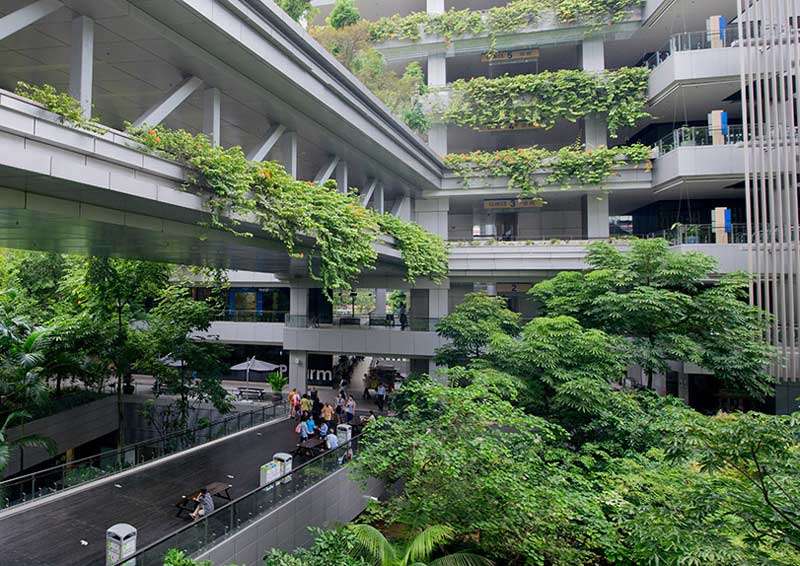
Enter the idea of a ‘living building’. Living buildings (and the Living Buildings challenge), aim to achieve sustainable development at all scales. Tall buildings, hospitals, laboratories, and other special buildings define the most advanced measure of possible sustainability in the built environment. They also can be made to bridge the gap between the natural and the artificial worlds.
What are Living Buildings?
Therefore, a building is ‘living’ when it achieves some key imperatives. Firstly, it has to generate its own energy on site using renewable sources. It must also capture and treat its own water. It must be constructed from non-toxic and sustainably sourced materials. And, it must be constructed on a previously developed site, as well as be beautiful and inspiring to its inhabitants.
Incorporating these imperatives means moving beyond the concept of ‘responsive architecture’ towards a ‘living’ building, that can interact and adapt to external stimuli (I. Hegazy et al., 2017).
Obviously, the built environment has a major effect on the natural and human environment. One of the ways to maximize environmental performance is by adopting these living building strategies. Fortunately, such strategies can be applied to buildings at any stage, from design, construction, renovation and deconstruction.
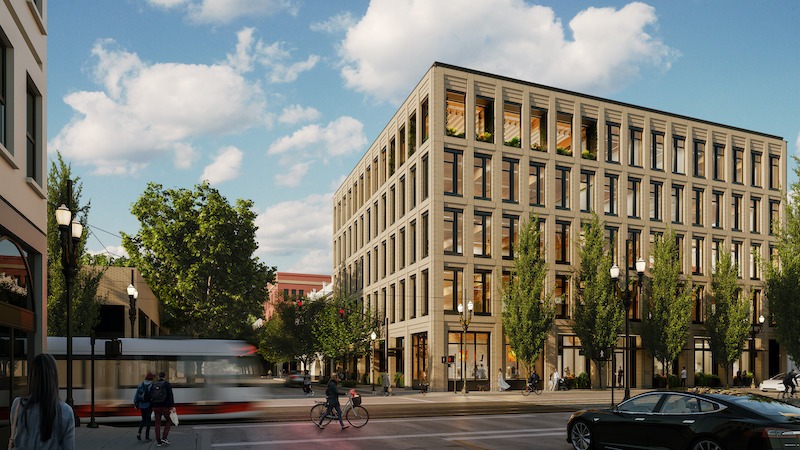
The Living Buildings Challenge: The Ultimate Standard
The Living Buildings Challenge is a philosophy, certification standard, and advocacy tool to help building projects become truly regenerative. It is the ultimate green building standard that can be applied to any building type around the world.
The goal is to improve the local environment, rather than simply reducing harm, by incorporating regenerative design solutions. The challenge is administered by the non-profit International Living Future Institute (ILFI), a global network dedicated to creating a healthy future for all.
In practice, certification by the Living Buildings Challenge means a construction strives to produce more energy than it uses. It collects its own potable water from rainfall, treats all grey and stormwater on site, uses the healthiest building materials available, and provides a beautiful, educational and healthy environment for its occupants.
However, the Living Buildings Challenge goes beyond green-building certifications, like Leadership in Energy and Environmental Design (LEED) and Cradle-to-Cradle. It elevates the goal from environmental mitigation to regeneration. Thus, every act of design and construction on a living building is intentioned with a green vision.
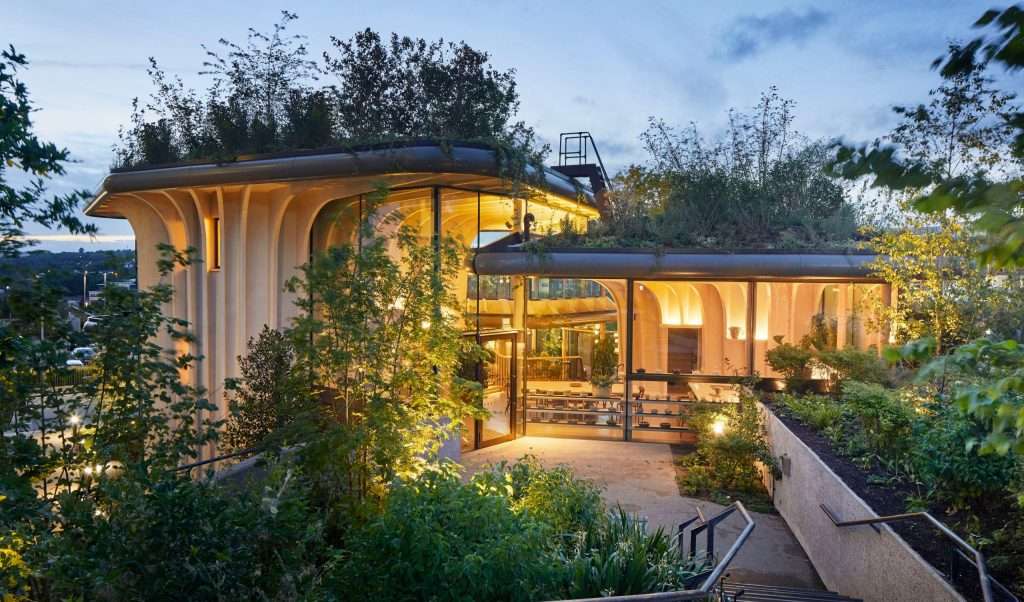
The Seven ‘Petals’
The Living Buildings Challenge is comprised of seven performance areas, or ‘Petals’: Place, Water, Energy, Health and Happiness, Materials, Equity, and Beauty.
- Place – This petal clearly articulates where it is acceptable to build, how to protect and restore a place once it has been developed, and how to encourage communities based on walkability, not automobiles. One of the imperatives of the Place petal is ‘Habitat Exchange’. This requires that, for each hectare of development, an equal amount of land off-site is set aside in perpetuity.
- Water – The intent of this petal is to realign how people use water and redefine ‘waste’ in the built environment. With scarcity of potable water becoming a serious issue in many countries, the Living Buildings Challenge envisions a future where all new buildings are configured based on the carrying capacity of the site. In other words, they are net-zero water facilities and use 100% of stormwater onsite.
- Energy – The Energy petal requires all buildings to rely solely on renewable forms of energy, and operate in a pollution-free manner year-round. Therefore, the Living Buildings Challenge requires all projects to produce net-zero energy, using methods like photovoltaic solar panels, natural daylighting, and other systems.
- Health and Happiness – The intent of the Health & Happiness petal is to create robust, healthy spaces and encourage a highly productive indoor environment. For example, the Petal requirement that every occupied interior space in the building has operable windows for fresh air and daylight.
- Materials – This Petal is about creating a successful materials economy, one that is non-toxic, transparent and socially equitable. Consequently, it is one of the most challenging petals of the Living Buildings Challenge. It requires that every building project does not contain any ‘Red List’ identified materials, including PVC and Formaldehyde. So, a detailed record of how every material was made by the manufacturer must be kept to attain certification. There are also many specifications on the types of timber that can be used and the locations where materials can be sourced.
- Equity – The Equity petal is focused on creating communities with equitable access, regardless of physical ability, age or socioeconomic status. One imperative of this petal is ‘Rights to Nature’. It requires that a project “may not block access to, nor diminish the quality of, fresh air, sunlight and natural waterways for any member of society or adjacent developments.”
- Beauty – The purpose of this petal is to design buildings that elevate our spirits. It is based simply on whether there are genuine efforts to create aesthetically pleasing designs, so there are currently no limitations or restrictions for this petal.
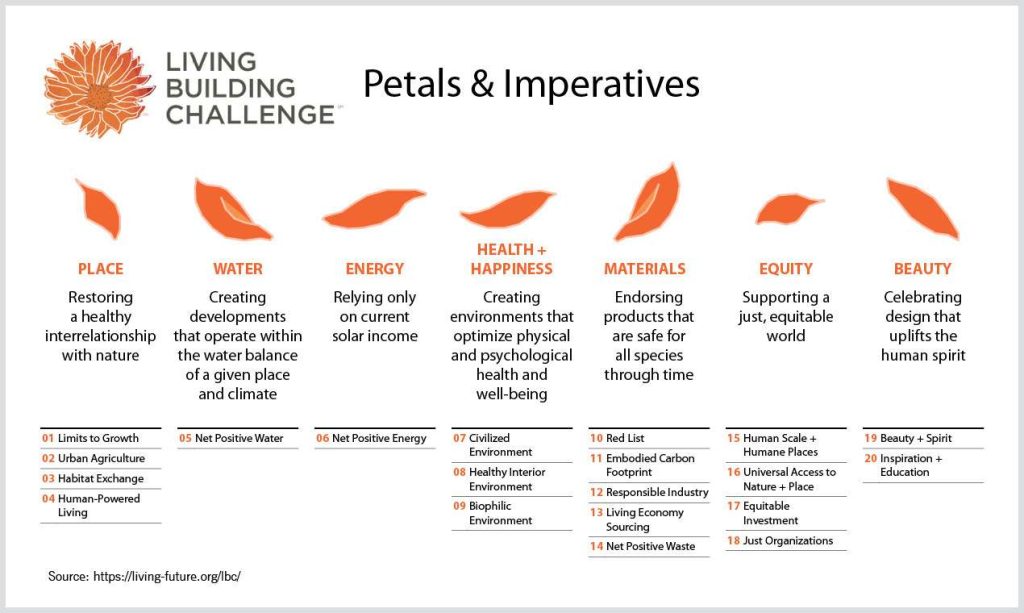
Each Petal is subdivided into Imperatives, for a total of twenty Imperatives in the Living Buildings Challenge. Imperatives can be applied to almost every conceivable building project, at any scale and in any location—be it a new building or an existing structure. The Living Buildings Imperatives seek to raise the bar and help new projects aspire to the most advanced measure of sustainability (I. Hegazy et al., 2017).
Types of Projects
The Living Buildings Challenge is versatile and applies to different project scopes, or Typologies. There are four Typologies, and teams must identify which one best aligns with their project’s scope to determine the imperatives that apply.
- New Building: any project that encompasses the construction of a new building.
- Existing Building: any project that alters either the envelope or the major systems of a building.
- Interior: any project that does not alter either the envelope or the major systems of a building.
- Landscape or Infrastructure: any project that does not include an enclosed structure as part of its primary program. Projects may be parks, roads, bridges, plazas, sports facilities, or trails.
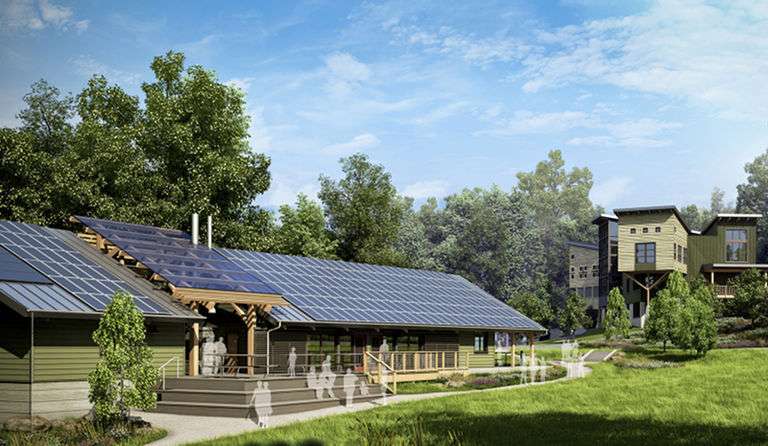
Maryland, were designed by Re:Vision Architecture to meet LBC standards interdependently. Grass
generates the energy while Moss provides the water. Source: BuildingGreen.com.
Certification Options
A building attains certification by achieving all imperatives identified in its typology. Also, there are different types of certifications, including:
Living Certification – Most projects aim to achieve ‘Living’ status. For this to happen, all 20 imperatives are mandatory for buildings, 15 for renovations, and 17 for landscape and infrastructure projects (I. Hegazy et al., 2017).
Petal Certification – Although attaining ‘Living’ status is the ultimate goal, meeting the imperatives of multiple petals is a substantial success in and of itself. For this reason, the living buildings challenge offers petal recognition. Project teams may pursue Petal Certification by satisfying the requirements of three or more Petals (at least one of the following must be included: Water, Energy or Materials ). Imperative 01, limits to growth and Imperative 20, inspiration and education are required.
Net Zero Energy Building Certification – Net-zero energy certification mainly obliges four of the imperatives to be achieved: 01, limits to growth, 06, net positive energy (reduced to 100%), 19, beauty and spirit and 20, inspiration and education. The requirement for Imperative 06, net positive energy, is reduced to 100%, whilst 105% is required for petal and living building certification only.
There are currently 390 projects around the world that are pursuing Living Building certification, but only 15 fully certified living buildings exist today. (However, 70 more projects have been Petal or Zero Energy certified.) The time and cost it takes to achieve all seven petals make the construction of a Living Building a true challenge with many benefits for those who complete it.

Living Building Certification. Source: LivingBuilding.gaetech.
Selecting Materials for Living Buildings
The living buildings challenge envisions a future where all materials in the built environment are replenishable and have no negative impact on human and ecosystem health (Hossaini et al., 2015).
There are many factors when it comes to selecting building materials. One has to take into account toxicity, performance, the environmental life cycle, cost, and other factors. As we gain more knowledge about the hazardous constituents of building materials , the excuses for using them in our buildings are becoming ever flimsier.
Red Listed Building Materials
Throughout their life cycle, building materials are responsible for many adverse environmental issues, including personal illness, habitat and species loss, pollution, and resource depletion.
Red lists identify hazardous compounds. They are typically used only when applying a robust rating system like the Living Buildings Challenge. Otherwise, restriction is enforced by progressive companies such as Google or Kaiser Permanente that specifically seek to exclude such materials.
When impacts can be reduced but not eliminated, there is an obligation not only to offset the damaging consequences associated with the construction process, but also to strive for corrections in the industry itself. Currently, it is impossible to gauge the true environmental impact and toxicity of the built environment, due to a lack of product-level information. However, the Living Buildings Challenge continues to shine a light on the need for transformative industrial practices.
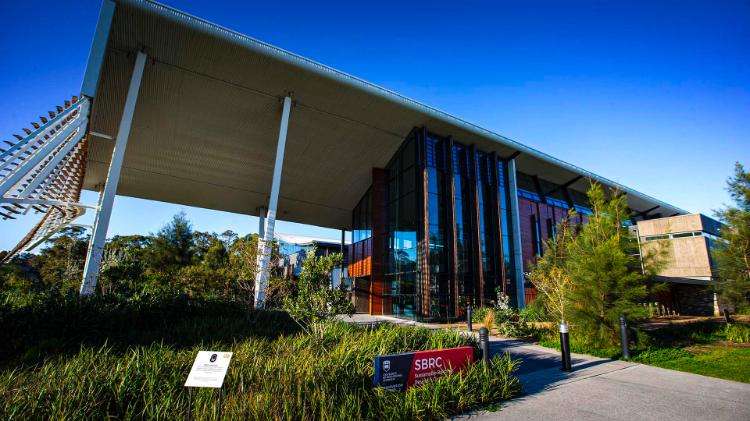
The Living Buildings Challenge ‘Worst in Class’
The Red List, maintained by ILFI, contains the worst in class building materials that are deemed harmful to humans. Avoiding or minimizing the use of these chemicals is vital to protect building occupants’ health.
The most commonly-used chemicals on the ILFI’s Red List:
- Pollute the environment
- Are bio-accumulating up the food chain until they reach toxic concentrations
- Harm construction and factory workers.
The list includes items such as asbestos, Chlorinated Polyethylene and Chlorosulfonated Polyethlene, Formaldehyde (added), Lead (added), Mercury, Polychlorinated Biphenyls (PCBs), Perfluorinated Compounds (PFCs), and Volatile Organic Compounds (VOCs). The complete Red list can be found here.
Innovative New Materials For Living Buildings
Building projects consume 50% of our resources from nature, often leading to added costs, delayed construction times, and wasted materials. To address these challenges, many innovative firms are developing a new generation of building materials.
Materials are being engineered to be smarter, stronger, self-sustaining, sleeker, and easier on the environment. The BIQ House in Hamburg, Germany provides a perfect glimpse of the future. Built with living algae, the BIQ is able to harness its own electricity. Not only possessed of an impressive sci-fi aesthetic from pop culture, its impact on the environment is a great advertisement for a sustainable future.
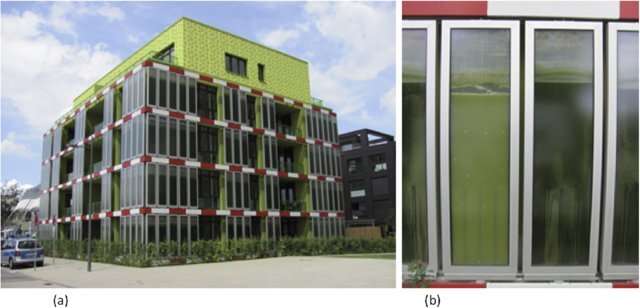
To keep a competitive edge, construction companies need to stay up-to-date with these material innovations. Buildings crafted with the latest materials are better equipped to solve ongoing environmental challenges. They reduce their carbon footprint, improve efficiency, and make a powerful impact on the industry.
Examples of Innovative Building Materials
The following are some examples of new, promising innovative materials set to change the building industry.
- Self-Healing Concrete – This material was found by inserting micron-sized calcium silicate spheres into the cement. This increases the strength of the cement, thus allowing manufacturers to use less concrete. Uses include reducing infrastructure maintenance requirements and cutting greenhouse gases.
- Graphene – This a 3D-printed carbon that has 5% of steel’s density but up to 200 times its strength. Uses include in light-weighted materials for vehicles and potentially in skyscrapers that could be up to 98,000+ feet.
- Aerographite – This is an atom-made material that has the ability to grow stronger when compressed. It is referred to as world’s lightest building material. It is 75 times lighter than styrofoam. Uses include in aviation materials, satellites, and purification systems.
- Laminated Timber – This is a kind of prefabricated timber with higher water resistance and strength over traditional wood. Uses include to support skyscrapers and reduce 150 tons of carbon per story.
- Modular Bamboo – This is a low-cost and fast growing material that can extend into different shapes and structures. Uses include building earthquake-resistant buildings, creating new architectural forms, and reinforcing steel bars.
- Spider Silk – This materials provides 340 times more durability than steel and contains resonance properties. Variants include synthetic spider silks that could be used for acoustic building tiles and laboratories.
- Rammed Earth – This materials is made by compacting soils with components including earth, chalk, lime, or gravel. Uses are based on Its low carbon footprint – It consumes less energy during its life cycle than conventional building materials. Instead, its thickness provides efficient insulation.
In addition to the examples above, there are many other innovative low carbon products available. There are also many more that are being researched and developed. One day, these materials may well replace concrete, plastics, glass and other derived materials. Furthermore, they may be produced without the need to burn fossil fuels and consume high amounts of energy.
The Many Benefits of Living Buildings
Living Buildings have many positives. They provide a range of environmental, economic and social benefits. Environmentally, they improve and protect biodiversity and ecosystems. Thus, they enhance air and water quality, reduce waste streams, and preserve and restore natural resources. Economically, they decrease operating costs, as well a create and shape markets for green products and services. In addition, they enhance occupant productivity, and improve life-cycle economic performance..Enhance occupant productivity.Improve life-cycle economic performanceSocially, they improve occupant comfort and health. They also heighten aesthetic qualities, minimize strain on local infrastructure, and enhance quality of life.
Buildings that achieve this level of performance can claim to be the ‘greenest’ anywhere in the world. They present as remarkable models for others to follow. From materials that generate their own energy, or provide greater structural protection, the future of our buildings is evolving. It’s true that many of these innovations are not yet realized at scale. However, they are transforming industry and may well be making their way into new projects over the next two decades.
Moving Forward
A sea-change in building, infrastructure and community design is required. Nothing less than that will abate the environmental impacts of building and construction. Indeed, this must become the focus and the great work of the new generation. Humans must remake our cities, towns, neighbourhoods, homes and offices, and all the spaces and infrastructure in between.
That is part of the necessary goal of reestablishing our relationship with the natural world. Not as entities separate from, but a part of the nature we inhabit.
To learn more about how The THRIVE Project is researching, educating and advocating for a future beyond sustainability, visit our website. You can follow our informative blog and podcast series, as well as find out about our regular live webinars featuring expert guests in the field. Sign up to our newsletter for regular updates.























